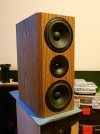I experimented several popular, highly regarded tweeters before like the famous Scan-Speak D3004/6600 AirCirc for example but I was not happy with any of them (I mean how they sounded in the complete system). Recently I tried that cheap, wg loaded Dayton soft dome and wow, one of the best tweeter that I've ever heard. I would choose this over the soft dome SS AirCirc any day.Well now, I was about to build something just like this, almost a cheaper DXT mon if you will, but it's good to hear some feedback on the idea. Guess I will pass.
Just try to find a cleaner waterfall or sonogram plot above 2 kHz amongst the tweeters on the site below! You won't succeed.
https://www.dibirama.altervista.org...n-audio-nd25fw-4-tweeter-1-4-ohm-40-wmax.html
Last edited:

